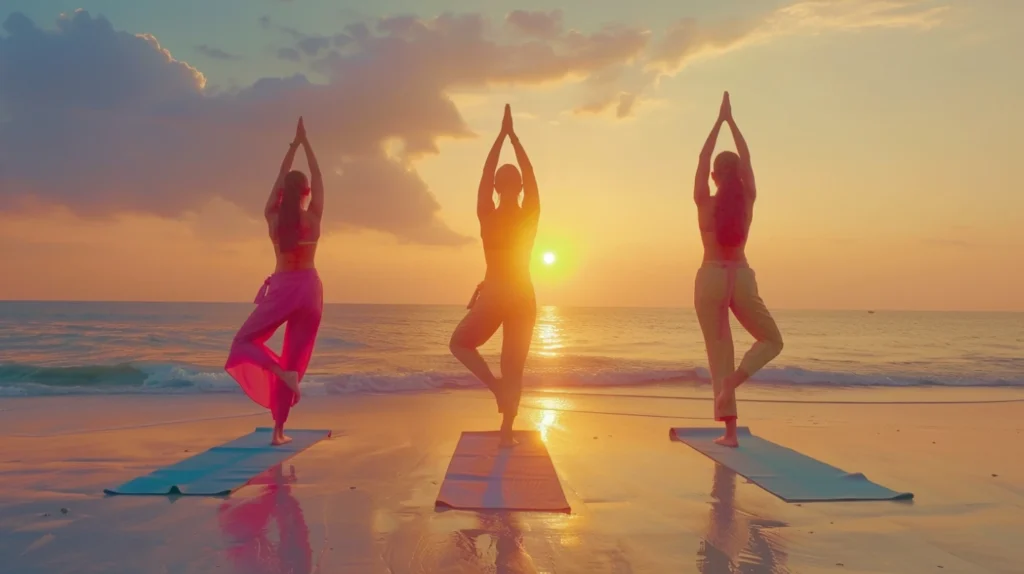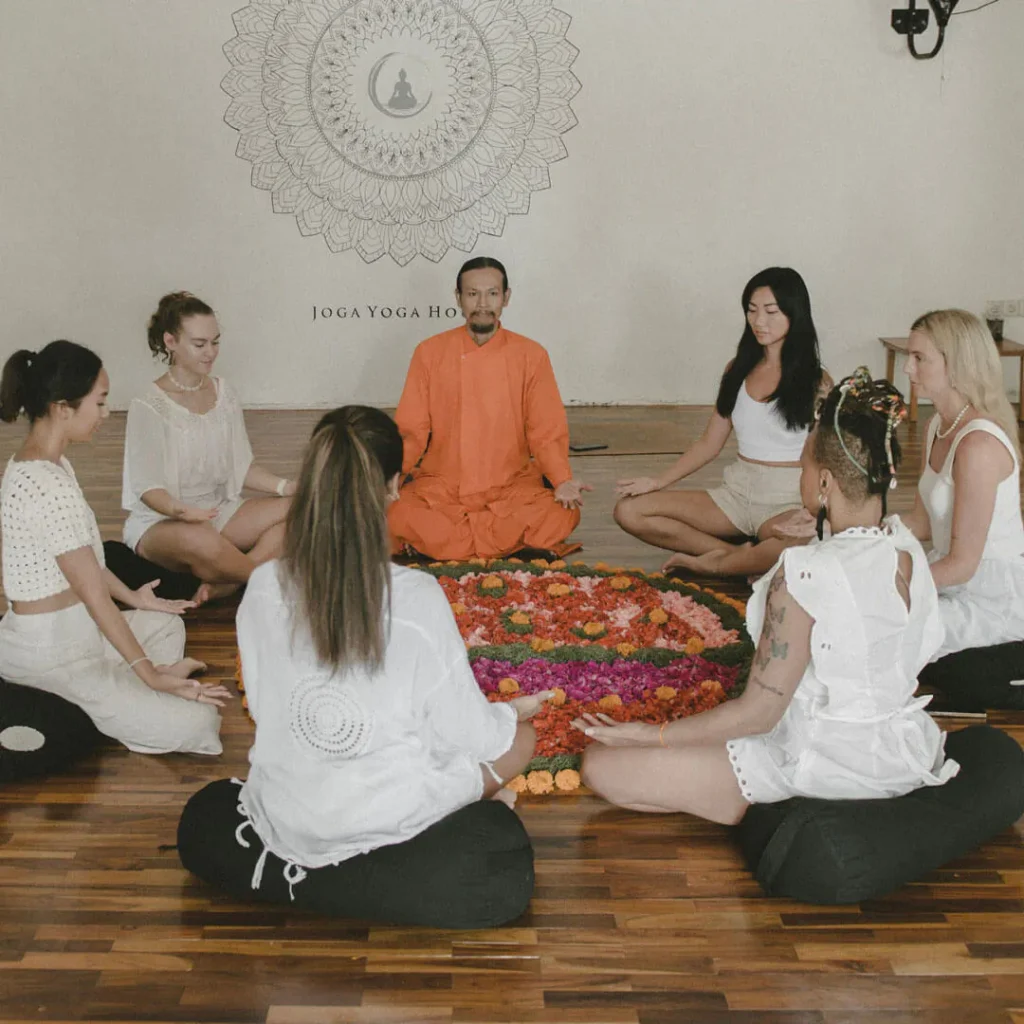Yoga Teacher Training (YTT) is a comprehensive program designed to deepen your understanding of yoga, enhance your teaching skills, and provide you with a recognized certification to instruct others. These programs are crucial for transforming their yoga practice into a professional career. Yoga Teacher Training in Bali offers an ideal setting for such an immersive learning experience due to its serene landscapes and rich cultural heritage.
- Enhance Personal Practice: Deepen your yoga practice and understanding through intensive training sessions and expert guidance from certified instructors.
- Career Opportunities: Open up career paths as a certified yoga instructor, equipped with the skills to teach worldwide. Programs in Bali often include Yoga Alliance certified courses, ensuring high standards of training.
- Cultural Immersion: Experience the vibrant culture and serene environment of Bali. Engage in traditional ceremonies, visit sacred temples, and connect with the local community to enhance your spiritual growth.
- Professional Certification: Gain a globally recognized certification, validating your expertise and ability to teach yoga anywhere in the world. Accredited programs provide the necessary credentials for global teaching opportunities.
- Community Building: Connect with like-minded individuals and build a supportive yoga community. Many training programs emphasize creating a health-conscious community where everyone feels valued and empowered to participate in the practice of yoga.
By starting a Yoga Teacher Training program in Bali, you not only advance your practice and career but also immerse yourself in a transformative journey that combines rigorous training with rich cultural experiences. This unique environment fosters both professional growth and personal enrichment, making it an ideal choice for aspiring yoga instructors.

Overview of Yoga Teacher Training Programs in Bali
Yoga Teacher Training programs are structured courses providing comprehensive yoga practice, teaching methodology, and philosophy education. These programs are designed to equip participants with the knowledge and skills needed to become proficient yoga instructors. Bali offers an ideal environment for these programs, combining rigorous training with cultural immersion.
Types of Programs:
- 100-hour Programs: These are introductory courses suitable for beginners looking to deepen their practice without committing to a full certification.
- 200-hour Programs: These standard certification programs, often recognized by the Yoga Alliance, cover essential aspects of yoga practice and teaching.
- 300-hour Programs: Advanced training for those who have completed a 200-hour program and wish to further their expertise and teaching skills.



Core Curriculum:
- Yoga Philosophy: Understanding ancient texts, principles, and ethics of yoga.
- Anatomy and Physiology: Learning the human body’s structure and how it relates to yoga practice.
- Teaching Methodology: Techniques for effective teaching, including communication skills, class structure, and student assessment.
Training Environment:
Yoga Teacher Training programs often occur in serene and picturesque retreat centers, providing an ideal setting for immersive learning. These centers typically feature:
- Spacious Yoga Studios: Surrounded by nature, providing a peaceful environment for practice.
- Comfortable Accommodation: Options range from private rooms to shared dormitories.
- Nutritious Meals: Vegetarian or vegan meals that support a healthy lifestyle.
- Cultural Experiences: Opportunities to engage with local traditions, ceremonies, and excursions.
Instructors’ Expertise:
Instructors in these programs are highly qualified, with diverse backgrounds and extensive experience. They bring a wealth of knowledge and expertise in various styles and aspects of yoga, including:
- Hatha and Vinyasa Yoga
- Ashtanga and Yin Yoga
- Meditation and Pranayama
- Yoga Therapy and Ayurveda
Certification Process:
The certification process involves several key steps:
- Enrollment: Register for the program and meet any prerequisites.
- Completion of Training Hours: Attending and participating in the required instructional hours.
- Practical Assessments: Demonstrating teaching skills through practice classes and evaluations.
- Written Exams: Testing knowledge of yoga philosophy, anatomy, and teaching methodology.
- Graduation: Receiving a certificate upon successful completion of the program, which allows for Yoga Alliance registration.
Yoga Teacher Training programs in Bali offer a holistic approach to learning. They blend rigorous academic study with practical teaching experience in a nurturing environment, making them an excellent choice for anyone looking to become a certified yoga instructor. Programs like those offered by Joga Yoga provide an exemplary model of these comprehensive training experiences.
Key Components in Yoga Teacher Training Programs
Yoga Teacher Training programs encompass several core components that are essential for developing a well-rounded understanding of yoga and its practices. These components ensure that participants gain a comprehensive education, combining theoretical knowledge with practical skills.
- Yoga Philosophy: This component explores the ancient texts, principles, and ethics of yoga. Understanding yoga philosophy is crucial as it provides the foundation for the practice, teaching the historical context, the spiritual dimensions, and the ethical guidelines that inform yoga instruction.
- Anatomy and Physiology: This area covers the human body’s structure and how it relates to yoga practice. Knowledge of anatomy is vital for ensuring safe practice and teaching. It includes the study of muscles, bones, and organs, as well as understanding how different asanas (poses) affect the body. This component also covers energy anatomy, such as chakras and nadis, and their relevance in yoga.
- Asanas and Alignment: Asanas, or yoga poses, and their proper alignment are fundamental to yoga practice. This component focuses on the correct execution of poses, how to instruct them, and the benefits they provide. Proper alignment is crucial for preventing injuries and maximizing the effectiveness of each pose. This training also covers the sequencing of asanas to create balanced and effective yoga classes.
- Pranayama and Meditation: This component includes the practice and teaching of pranayama (breathing techniques) and meditation. These practices are essential for managing energy, enhancing mental focus, and promoting overall well-being. Emerging practices and lesser-known techniques are increasingly being incorporated, highlighting their growing importance in modern yoga training.
Effective Strategies for Choosing the Right Yoga Teacher Training Program
Choosing the right Yoga Teacher Training program is crucial for ensuring a meaningful and enriching experience. Here are some effective strategies to help you make an informed decision.
- Research Programs: Investigate different YTT programs and their offerings. Look for comprehensive curriculums that cover essential aspects like yoga philosophy, anatomy, teaching methodology, and practicum. For instance, Joga Yoga provides detailed information on their 100-hour, 200-hour, and 300-hour programs, helping you understand what to expect from each.
- Evaluate Instructors: Assess the qualifications and teaching styles of the instructors. Experienced and certified teachers can greatly enhance your learning experience. At Joga Yoga, for example, instructors bring diverse expertise from various yoga styles and therapeutic practices, ensuring you receive well-rounded training.
- Consider Location: Reflect on how the location impacts your learning experience. Bali, with its serene environment and vibrant culture, offers an ideal setting for immersive yoga training. Locations like retreat centers provide a peaceful and conducive atmosphere for learning and personal growth.
- Check Accreditation: Ensure the program is accredited by a recognized yoga alliance, such as Yoga Alliance. This accreditation signifies that the program meets high standards of quality and will be recognized globally. Joga Yoga’s programs are Yoga Alliance certified, guaranteeing that you receive a credible and internationally recognized certification.
- Read Reviews: Look for testimonials and reviews from past students. Reviews can provide insights into the program’s effectiveness, the quality of instruction, and the overall experience. Positive feedback from alumni, such as those found on Joga Yoga’s website and review platforms, can help you gauge the program’s impact and reputation.
- Site Visits: If possible, visit the training centers to get a firsthand feel of the environment and facilities. For example, a site visit to Joga Yoga in Canggu allows you to experience the serene setting, spacious studios, and comfortable accommodations firsthand.
- Consultation Calls: Schedule calls with program coordinators to ask questions and clarify doubts about the program details and logistics. Joga Yoga offers consultation calls where you can speak directly with coordinators to understand more about their programs, instructor expertise, and what to expect during the training.
These strategies and tools can help you choose a YTT program that aligns with your personal goals and professional aspirations. For a holistic and enriching experience, consider programs like Joga Yoga YTT, which provide a blend of rigorous training, expert instruction, and cultural immersion in a serene setting.
Essential Tools for Yoga Teacher Training in Bali
Yoga Teacher Training requires several essential tools and resources to enhance learning and practice. These tools support your physical, mental, and emotional development throughout the training.
- Yoga Mats and Props: Having the right equipment, such as a quality yoga mat and props like blocks, straps, and bolsters, is crucial. These tools assist in achieving proper alignment, enhancing comfort, and preventing injuries during practice.
- Educational Materials: Books, manuals, and online resources provide valuable information on yoga philosophy, anatomy, and teaching methodologies. Access to these materials ensures that you can study and reference essential concepts both during and after your training.
- Personal Journal: Keeping a journal to track your progress and reflections is highly beneficial. Writing down your experiences, insights, and questions helps consolidate your learning and supports personal growth.
- Healthy Diet: Nutritional advice and access to healthy meals support your physical and mental well-being. A diet rich in nutrients enhances energy levels, aids concentration, and supports overall health during the intensive training period.
- Local Support Networks: Engaging with local yoga communities provides additional support and enriches your training experience. Connecting with fellow practitioners and teachers can offer guidance, encouragement, and opportunities for continued learning and practice.
By incorporating these essential tools into your Yoga Teacher Training in Bali, you can maximize your learning experience and fully benefit from the program.
Insights from Experienced Yoga Instructors
Experienced yoga instructors offer valuable insights and advice that can significantly enhance your Yoga Teacher Training in Bali. Here are some key tips from seasoned professionals.
- Commitment to Practice: Daily practice is essential for growth in yoga. Seasoned instructors emphasize that consistent practice not only improves physical abilities but also deepens your understanding of yoga philosophy and enhances your teaching skills. For example, one instructor at Joga Yoga shares how dedicating an hour each day to practice transformed her approach to teaching, making her more confident and intuitive.
- Adaptability: Being open to different teaching styles and methodologies is crucial. Instructors with diverse backgrounds bring unique perspectives and techniques. Adaptability allows you to learn from various styles and integrate them into your practice and teaching. A Joga Yoga instructor recounts how adapting to different styles during her training in Bali enriched her teaching repertoire and broadened her approach to yoga.
- Mindfulness: Incorporating mindfulness into both teaching and personal practice is vital. Mindfulness enhances the quality of your teaching by fostering a deeper connection with your students and creating a more focused and present practice environment. An instructor narrates how mindfulness practices learned during her training helped her handle classroom dynamics better and provide more personalized guidance to her students.
- Community Engagement: Building connections within the yoga community is beneficial for both personal and professional growth. Engaging with peers, mentors, and local yoga communities fosters a supportive network that can provide encouragement, feedback, and opportunities for collaboration. A Joga Yoga alumnus describes how being part of a close-knit yoga community in Bali provided her with lifelong friendships and professional connections supporting her career.
- Continuous Learning: Staying updated with new developments in yoga is essential. The field of yoga is constantly evolving, with new research, techniques, and philosophies emerging. Continuous learning ensures that you remain knowledgeable and can offer the best possible instruction to your students. An instructor highlights the importance of attending workshops and advanced training programs to stay current and inspired.
Common challenges in YTT include managing physical demands, maintaining motivation, and integrating new knowledge. Here are some strategic solutions:
- Managing Physical Demands: Ensure proper rest, hydration, and nutrition. Practice gentle yoga and meditation to support recovery.
- Maintaining Motivation: Set clear goals and track progress. Engage in group practice sessions to stay motivated and accountable.
- Integrating New Knowledge: Use study groups and discussion forums to deepen understanding—practice teaching with peers to apply new concepts.
By following these insights and strategies, you can navigate the challenges of Yoga Teacher Training and emerge as a confident and skilled yoga instructor.
Conclusion and Further Resources
Yoga Teacher Training in Bali offers a transformative experience that combines rigorous training with cultural immersion. Key points discussed include the benefits of enhancing personal practice, opening career opportunities, gaining professional certification, and building a supportive community. Additionally, we explored various aspects of YTT programs such as types, core curriculum, training environments, instructor expertise, and essential tools for successful training. Insights from experienced instructors and strategies for choosing the right program were also highlighted.
Further Resources:
- “The Heart of Yoga” by T.K.V. Desikachar: An essential read that provides a comprehensive guide to the philosophy and practice of yoga, perfect for deepening your understanding of yoga principles.
- “Light on Yoga” by B.K.S. Iyengar: This book offers detailed instructions and illustrations of various yoga asanas, making it a valuable resource for both students and teachers.
- Yoga Alliance Website: Visit the Yoga Alliance website for information on accredited programs, certification standards, and continuing education opportunities.
- Online Courses from Joga Yoga: Explore additional online courses offered by Joga Yoga to complement your in-person training, covering topics such as advanced asanas, yoga therapy, and meditation techniques.
- Professional Organizations: Join professional organizations like the International Association of Yoga Therapists (IAYT) for access to research, resources, and networking opportunities within the yoga community.
These resources will help you continue your journey in yoga, providing valuable knowledge and support as you grow both personally and professionally.
Frequently Asked Questions (FAQ)
What is the impact of the Bali environment on yoga training?
The serene and culturally rich environment of Bali greatly enhances the yoga training experience. The island’s natural beauty, including its lush landscapes and tranquil beaches, provides a peaceful setting that promotes relaxation and mindfulness. Additionally, Bali’s vibrant culture and spiritual heritage offer a unique context for deepening your yoga practice and understanding, making the training experience both immersive and transformative.
How do different yoga styles taught affect the training experience?
Learning multiple yoga styles broadens the scope of practice and enriches the training experience. Exposure to various styles such as Hatha, Vinyasa, Ashtanga, and Yin yoga allows trainees to understand different techniques, benefits, and teaching methods. This diversity equips future instructors with a versatile skill set, enabling them to cater to a wide range of student needs and preferences.
Can online components be part of the training?
Incorporating online learning components into yoga teacher training can be highly beneficial. Online modules offer flexibility, allowing students to study theoretical aspects like yoga philosophy and anatomy at their own pace. They also provide access to a wealth of resources, including video lectures and digital manuals, which can complement in-person training sessions. Programs like those offered by Joga Yoga sometimes include hybrid options that blend online and offline learning for a comprehensive educational experience.
What risk management techniques are essential for training?
Key risk management practices in yoga training include proper warm-ups, correct alignment, and the use of props to prevent injuries. Instructors should emphasize the importance of listening to one’s body and avoiding overstretching. Regularly incorporating rest and recovery periods into the training schedule is also crucial. Understanding anatomy and physiology helps in identifying potential risk areas and managing them effectively.
How significant is the role of cultural immersion in the training program?
Cultural immersion plays a significant role in enhancing learning and personal growth during yoga teacher training in Bali. Engaging with local traditions, participating in ceremonies, and learning from Balinese yoga practitioners provide a deeper appreciation of the cultural context of yoga. This immersion fosters a holistic understanding of yoga as both a physical and spiritual practice, enriching the overall training experience.
What are the benefits of using specific tools or resources tailored for training in Bali?
Utilizing local resources and supports tailored for training in Bali offers numerous advantages. Access to high-quality yoga mats and props, educational materials from renowned local instructors, and nutritious meals that cater to dietary needs all enhance the learning experience. Additionally, connecting with the local yoga community provides support, inspiration, and opportunities for continued practice and growth after the training program.




